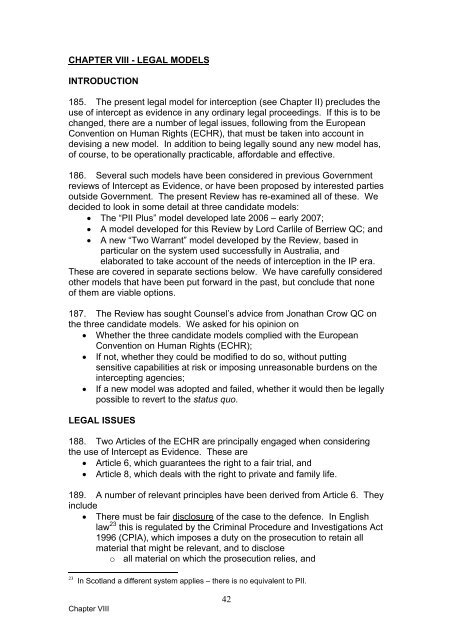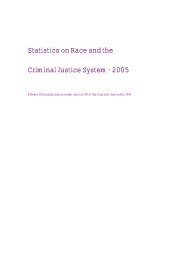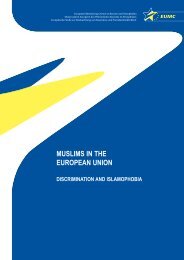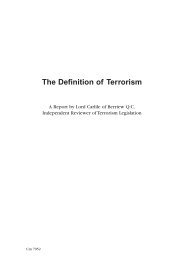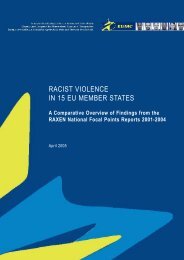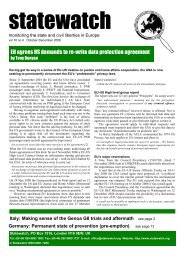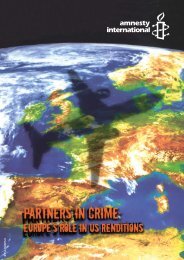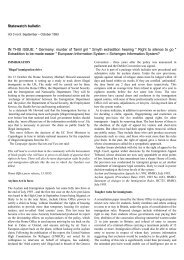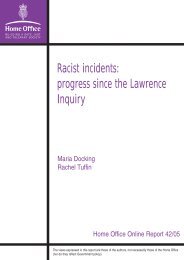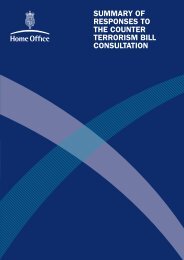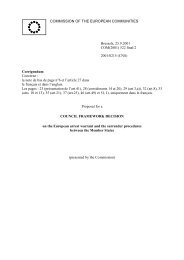Privy Council Review of intercept as evidence: report - Official ...
Privy Council Review of intercept as evidence: report - Official ...
Privy Council Review of intercept as evidence: report - Official ...
You also want an ePaper? Increase the reach of your titles
YUMPU automatically turns print PDFs into web optimized ePapers that Google loves.
CHAPTER VIII - LEGAL MODELS<br />
INTRODUCTION<br />
185. The present legal model for <strong>intercept</strong>ion (see Chapter II) precludes the<br />
use <strong>of</strong> <strong>intercept</strong> <strong>as</strong> <strong>evidence</strong> in any ordinary legal proceedings. If this is to be<br />
changed, there are a number <strong>of</strong> legal issues, following from the European<br />
Convention on Human Rights (ECHR), that must be taken into account in<br />
devising a new model. In addition to being legally sound any new model h<strong>as</strong>,<br />
<strong>of</strong> course, to be operationally practicable, affordable and effective.<br />
186. Several such models have been considered in previous Government<br />
reviews <strong>of</strong> Intercept <strong>as</strong> Evidence, or have been proposed by interested parties<br />
outside Government. The present <strong>Review</strong> h<strong>as</strong> re-examined all <strong>of</strong> these. We<br />
decided to look in some detail at three candidate models:<br />
The “PII Plus” model developed late 2006 – early 2007;<br />
<br />
<br />
A model developed for this <strong>Review</strong> by Lord Carlile <strong>of</strong> Berriew QC; and<br />
A new “Two Warrant” model developed by the <strong>Review</strong>, b<strong>as</strong>ed in<br />
particular on the system used successfully in Australia, and<br />
elaborated to take account <strong>of</strong> the needs <strong>of</strong> <strong>intercept</strong>ion in the IP era.<br />
These are covered in separate sections below. We have carefully considered<br />
other models that have been put forward in the p<strong>as</strong>t, but conclude that none<br />
<strong>of</strong> them are viable options.<br />
187. The <strong>Review</strong> h<strong>as</strong> sought Counsel’s advice from Jonathan Crow QC on<br />
the three candidate models. We <strong>as</strong>ked for his opinion on<br />
Whether the three candidate models complied with the European<br />
Convention on Human Rights (ECHR);<br />
If not, whether they could be modified to do so, without putting<br />
sensitive capabilities at risk or imposing unre<strong>as</strong>onable burdens on the<br />
<strong>intercept</strong>ing agencies;<br />
If a new model w<strong>as</strong> adopted and failed, whether it would then be legally<br />
possible to revert to the status quo.<br />
LEGAL ISSUES<br />
188. Two Articles <strong>of</strong> the ECHR are principally engaged when considering<br />
the use <strong>of</strong> Intercept <strong>as</strong> Evidence. These are<br />
Article 6, which guarantees the right to a fair trial, and<br />
Article 8, which deals with the right to private and family life.<br />
189. A number <strong>of</strong> relevant principles have been derived from Article 6. They<br />
include<br />
There must be fair disclosure <strong>of</strong> the c<strong>as</strong>e to the defence. In English<br />
law 23 this is regulated by the Criminal Procedure and Investigations Act<br />
1996 (CPIA), which imposes a duty on the prosecution to retain all<br />
material that might be relevant, and to disclose<br />
o all material on which the prosecution relies, and<br />
23 In Scotland a different system applies – there is no equivalent to PII.<br />
Chapter VIII<br />
42


